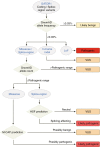The landscape of epilepsy-related GATOR1 variants
- PMID: 30093711
- PMCID: PMC6292495
- DOI: 10.1038/s41436-018-0060-2
The landscape of epilepsy-related GATOR1 variants
Erratum in
-
Correction to: The landscape of epilepsy-related GATOR1 variants.Genet Med. 2019 Jul;21(7):1671. doi: 10.1038/s41436-018-0284-1. Genet Med. 2019. PMID: 30158694 Free PMC article.
-
Correction: The landscape of epilepsy-related GATOR1 variants.Genet Med. 2019 Aug;21(8):1896. doi: 10.1038/s41436-018-0325-9. Genet Med. 2019. PMID: 30262923 Free PMC article.
Abstract
Purpose: To define the phenotypic and mutational spectrum of epilepsies related to DEPDC5, NPRL2 and NPRL3 genes encoding the GATOR1 complex, a negative regulator of the mTORC1 pathway METHODS: We analyzed clinical and genetic data of 73 novel probands (familial and sporadic) with epilepsy-related variants in GATOR1-encoding genes and proposed new guidelines for clinical interpretation of GATOR1 variants.
Results: The GATOR1 seizure phenotype consisted mostly in focal seizures (e.g., hypermotor or frontal lobe seizures in 50%), with a mean age at onset of 4.4 years, often sleep-related and drug-resistant (54%), and associated with focal cortical dysplasia (20%). Infantile spasms were reported in 10% of the probands. Sudden unexpected death in epilepsy (SUDEP) occurred in 10% of the families. Novel classification framework of all 140 epilepsy-related GATOR1 variants (including the variants of this study) revealed that 68% are loss-of-function pathogenic, 14% are likely pathogenic, 15% are variants of uncertain significance and 3% are likely benign.
Conclusion: Our data emphasize the increasingly important role of GATOR1 genes in the pathogenesis of focal epilepsies (>180 probands to date). The GATOR1 phenotypic spectrum ranges from sporadic early-onset epilepsies with cognitive impairment comorbidities to familial focal epilepsies, and SUDEP.
Keywords: DEPDC5; Focal cortical dysplasia; Genetic focal epilepsy; SUDEP; mTORC1 pathway.
Conflict of interest statement
The authors declare no conflict of interest.
Figures




References
Publication types
MeSH terms
Substances
Grants and funding
LinkOut - more resources
Full Text Sources
Other Literature Sources
Medical

